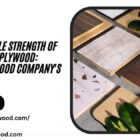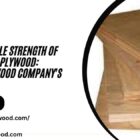The demand for plywood has been increasing rapidly over the past few years. A surge in the people moving to cities has led to an increase in the construction of more buildings, production of vehicles at a larger scale, etc., and has become one of the main reasons for the increased demand. The raw materials used in the development of all these things usually include plywood, medium-density fiberboard (MDF), particleboard or chipboard, and oriented standard board (OSB). So, you might be wondering what plywood really is and why it is so popular.

Well, here is all you need to know about plywood: –
Plywood is a material that is manufactured from thin layers or plies of wood veneers glued together by resin under high pressure. It is a thick, strong, and flexible sheet. It is preferred over wood as it is cheaper, reliable, and long-lasting.
Now that you have a basic grasp of what plywood is let’s look at how you can distinguish them based on grade and thickness. Let’s face the reality that it can become very tough to choose plywood if you are not properly familiar with the options that are available to you. This is because different types of plywood fit the different requirements that you might have based on weight, cost, weather conditions, and other factors.
The quality and appearance of plywood vary from grade to grade. There are primarily four grades of plywood-A, B, C, and D- but each veneer contains two grades an example would be ‘AB’ or ‘BC’ where the first letter refers to the grade of the face veneer and the second letter is associated with the grade of the back veneer. In some cases, there is also an X at the of the compound name. But there is nothing to worry about it just means that it has a certain level of exposure to moisture.
The thickness of the ply is decided by how many sheets of veneers are used to make the board. The minimum number that is used in making a board is 3 plies. Plywood with fewer plies is relatively weaker and thus it finally comes down to the purpose for which the plywood is to be used that decides which thickness level to go for. There are 3, 5, and multi-ply options that you can choose from.
You can congratulate yourselves on having learned a lot more about plywood. Magnus Plywood offers a premium range of plywood products in all sectors and keeps the needs of the customers in mind by offering them quality products at affordable prices.



